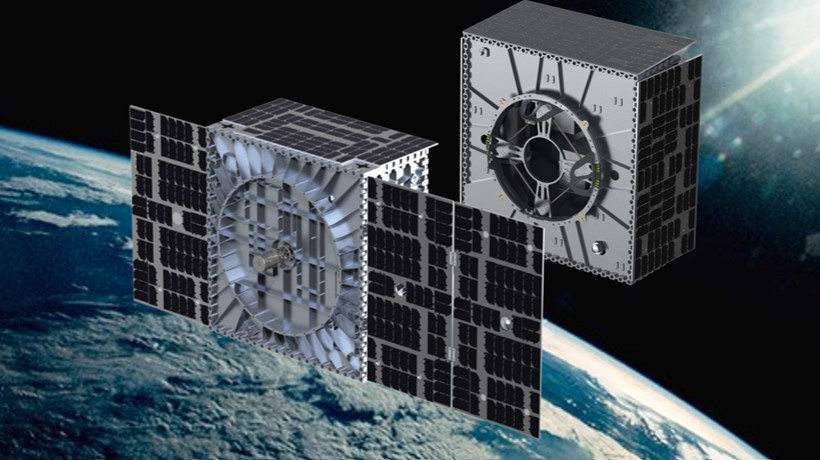There are few missions that more acutely embody the “space is hard” adage than Atomos Space's first test mission, which the company has more than once managed to pull back from the brink of disaster.
This demonstration mission, called Mission-1, was launched into orbit on a SpaceX Falcon 9 rocket on March 4. The mission's goals are ambitious in the extreme: The two spacecraft — an orbital transfer vehicle called Quark-LITE and a target vehicle called Quark-LITE Gluon — will ultimately demonstrate highly complex maneuvers including rendezvous, docking, orbital transfer and in-orbit refueling.
The company had two major problems with communications and spacecraft rotation rate, and it (largely) solved both problems, despite massive limitations, scarce data packets, and very limited bandwidth. (In fact, it was so limited that the team had to limit its flight software updates to a string of text just 145 characters long.)
“It's been tough,” Vanessa Clark, CEO and co-founder of Atomos, told TechCrunch.
The company's chief operating officer and co-founder, William Kowalski, agreed. “What makes it so difficult, even in our case, is that we are trying to extrapolate the state of a very complex system from maybe 100 bytes of data,” he said. “It's a lot, you're making guesses about what caused this, knowing that some of those guesses might take you down a path that you'll never recover from.”
The problems began just hours after the two spacecraft, mated together, deployed from the Falcon 9 rocket's upper stage. The deployment was symbolic, and Atomos received its first communication from the spacecraft seven minutes after deployment. The mood was festive.
But it took 40 minutes until the company got the next ping. Then eight hours.
Atomos was expecting data packets every two minutes.
“the worst [day] “It was Monday when we launched that evening,” Kowalski said. “It was 11 at night, and it was me and the chief engineer… and we didn't hear anything, and we're just thinking, 'Did we fail? Did they die? We tried it and it didn't work. It was a punch in the gut, really.'
Mission controllers did not determine the root cause until 24 to 48 hours after deployment, and they did so with the help of another company with assets in orbit. After pulling some strings, they were able to get on the phone with a senior systems engineer at satellite communications company Iridium. The spacecraft was using third-party modems that took advantage of Iridium's inter-satellite link network, as well as using the Iridium constellation as relay satellites. The Atomos spacecraft was moving too fast, and in direct conflict, to perform a data “handshake” with the Iridium satellites to actually transmit the information back to Earth.
Atomos engineers ended up pushing a series of software updates that reduced the duty cycle and ensured the radios were always powered on, even if the spacecraft was in a low-power state.
While engineers were trying to fix the communications problem, they ran into a different problem: The spacecraft was rolling at an extremely fast rate of 55 degrees per second (it was designed to handle a rotation rate of up to 5 degrees per second). In addition, the spacecraft was rotating so slowly that the solar arrays were no longer facing the sun. This meant that it was a race against time, and against the complete death of spacecraft batteries.
“We had two graphs,” Kowalski said. “We plot the direction of our force when we think we will be directed away from the sun and we will be [at] Zero energy, our rate of disintegration. It was a matter of reducing the rate of decomposition to zero before the energy reached zero.
The problem was exacerbated by limited communications; The teams were not able to conclusively confirm that anything was wrong until the fourth day after deployment, and the spacecraft was only able to absorb new commands in between long periods of essentially no communications.
Slowly, over days, they were able to slow down the spacecraft. The team achieved another big win when it was able to establish high-bandwidth communications, a space-to-space link on Quark-LITE that talks over the Inmarsat network. The company made its first attempt to obtain high-bandwidth communications on Thursday, successfully maintaining communications with the spacecraft for six minutes.
During that period, mission controllers received 17 times more data than they had since launch. This provided mission controllers with huge amounts of data about the health of the spacecraft. It's not all positive news — one of the battery packs on the OTV was badly damaged by aggressive cycling, and the GPS apparently needed to be reset aboard one of the spacecraft — but those are easy fixes, Clark said.
By Tuesday or Wednesday, the company aims to have the payment system up and running. If all goes according to plan, and engineers can confirm that the prop system provides precise steering and control, they will test operations with torque rods and reaction wheels. The company aims to separate the spacecraft in about a month, with the goal of completing all mission objectives by the end of June.
Kowalski and Clark attribute some of the startup's success to the fact that it is largely vertically integrated. The team – which put in 100 hours a week in the first week after deployment – was able to leverage its intimate knowledge of spacecraft design to solve problems that arose.
“Obviously it was very painful, but it's as if the CEO of Nvidia was saying, 'I wish you great suffering.' “We went through it and it wasn't great in the moment, but now that we've gone through it, we're… Certainly more accomplished.”
